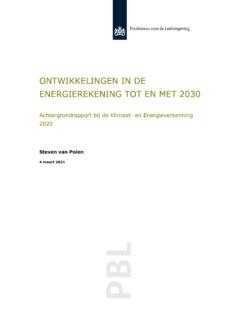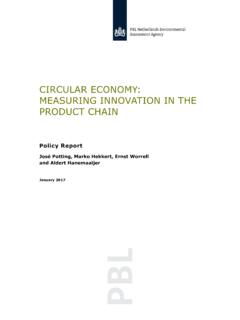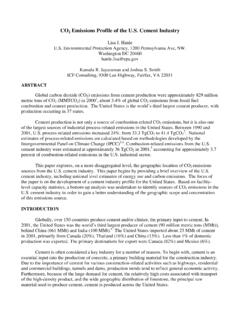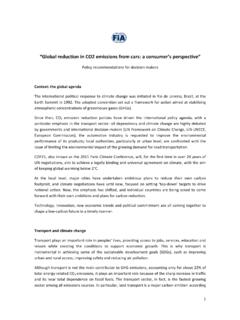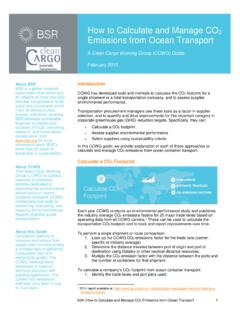Transcription of Trends in global CO2 and total greenhouse gas emissions ...
1 Trends IN global CO2 AND total greenhouse GAS emissions 2020 Report Olivier and Peters December 2020 PBL | 2 Trends in global CO2 and total greenhouse gas emissions : 2020 Report PBL Netherlands Environmental Assessment Agency The Hague, 2020 PBL publication number: 4331 Corresponding author Authors J. Olivier and Peters Acknowledgements We thank the International Energy Agency (IEA), the Geological Survey (USGS), International Fertiliser Association (IFA), the global Gas Flaring Reduction Partnership (GGFR) of the World Bank and the global Carbon Project (GCP) for providing recent statistics.
2 We thank the members of the EDGAR team at EC-JRC for their support in the data compilation of the CO2 Fast Track 2019 and Pieter Boot and Michel den Elzen (PBL) and Monica Crippa (EC-JRC) for their comments. Graphics PBL Beeldredactie Production coordination PBL Publishers This publication can be downloaded from: Parts of this publication may be reproduced, providing the source is stated in the form: Olivier and Peters (2020), Trends in global CO2 and total greenhouse gas emissions : 2020 report. PBL Netherlands Environmental Assessment Agency, The Hague.
3 PBL Netherlands Environmental Assessment Agency is the national institute for strategic policy analysis in the fields of the environment, nature and spatial planning. We contribute to improving the quality of political and administrative decision-making by conducting outlook studies, analyses and evaluations in which an integrated approach is considered paramount. Policy relevance is the prime concern in all of our studies. We conduct solicited and unsolicited research that is both independent and scientifically sound. PBL | 3 Contents SUMMARY 4 1 INTRODUCTION 10 2 Trends IN global emissions 13 Introduction 13 global Trends in total greenhouse gas emissions 15 global Trends in CO2 emissions 19 global emissions of other greenhouse gases 23 COVID-19 global Trends and future implications 30 3 Trends IN LARGEST EMITTING COUNTRIES AND THE EU-28 33 China 36 United States 39 European Union 45 India 52 Russian Federation 56 Japan 60 APPENDICES 65 A.
4 CO2 emissions per country, per capita, and per USD of GDP 65 B. greenhouse gas emissions : CH4, N2O, F-gases, total per capita and per USD of GDP 69 C. Annual change in global sectoral emissions in recession years and in other years 76 REFERENCES 80 PBL | 4 Summary Growth of in global greenhouse gas emissions in 2019 In 2019, the growth in total global greenhouse gas (GHG) emissions (excluding those from land-use change) continued at a rate of ( 1%), reaching gigatonnes of CO2 equivalent1 2 (GtCO2 eq) (with a 95% uncertainty range of 8%3). Although the growth is half that seen in 2018, it is a continuation of the average annual growth rate of since 2012, which is markedly lower than the growth rates seen in the first decade of this century ( on average) (Figure ).
5 The 2019 global GHG emissions amounted to GtCO2 eq when also including those from land-use change (which are estimated at a very uncertain GtCO2 eq ( 50%)), which is an increase of 70% compared to 2018. These increases occurred while global economic growth in 2019 was , which is somewhat lower than the growth in global Gross Domestic Product (GDP) of in 2017 and in 2018. The 2019 global GHG emissions excluding those from land-use change were about 59% higher than in 1990 and 44% higher than in 2000. The increase in global GHG emissions in 2019 was mainly due to a increase in global CO2 emissions from fossil-fuel combustion and industrial non-combustion processes including cement production, which contributed almost two thirds to the total GHG increase in 2019.
6 Other greenhouse gas emissions , CH4, N2O and F-gases, increased in 2019 by a respective , and Although global GHG emissions mostly consist of CO2 (about 74%, including 7 percentage points, on average, from land-us e change), other significant shares are from methane, nitrous oxide and fluorinated gases (F-gases) with 17 %, 5% and 3%, respectively. Among the countries that contributed most to the global increase excluding land-use change (about 570 MtCO2 eq), China stands out with an increase of about 420 MtCO2 eq (+ ), followed by 50 MtCO2 eq in both Indonesia (+ ), Vietnam (+ ) and India (+ ).
7 These increases were partly counterbalanced by countries with decreasing GHG emissions , in particular by that in the European Union (EU-284) ( ) and the United 1 greenhouse gas emissions , excluding land-use change, are based on EDGAR FT2019 (this report) and those that include CO2 emissions from land-use change (LUC) are from Houghton and Nassikas (2017) with our own estimate for 2019. The GtCO2 eq of LUC emissions in 2019 also include GtCO2 eq in CH4 and N2O emissions from forest and peat fires that was obtained from preliminary data for 2019 in the global Fire emissions Database version data set (Van der Werf et al.)
8 , 2017). For CH4, N2O and the F-gases, this report uses the global Warming Potential (GWP) metric from the Fourth Assessment Report (AR4) of the IPCC (2007), which is also used by industrialised countries in their annual national emissions inventory reports submitted to the UNFCCC ( Annex I countries). The time horizon of the GWPs is 100 years. Please note that developing countries officially report their emissions using GWPs from the Second Assessment Report (SAR) of the IPCC. The largest difference is in the GWP of CH4: the GWP value is 25 in the AR4 and 21 in the SAR, so almost one fifth larger.
9 2 The historical EDGAR GHG emission Trends in this report (excluding those from land-use change) were also presented in UNEP s emissions Gap Report 2020 (UNEP, 2020; Moisio et al., 2020). 3 We estimated uncertainties with two standard deviations for global emissions of 6% for CO2 (excluding LUC), 25% for CH4, 30% for N2O and 20% for fluorinated gases (UNEP, 2012), resulting in 7% uncertainty, and added an extra 1% to account for the uncertainty in the 2018 2019 GHG emissions trend. These uncertainty ranges are consistent with those presented in Appendix 1 of UNEP s emissions Gap Report 2012 (UNEP, 2012) and IPCC AR5 (Blanco et al.)
10 , 2014). 4 This report covers emissions up to and including 2019. This means the United Kingdom was still a Member State of the European Union (it exited the EU on 31 January 2020). Therefore, the United Kingdom was PBL | 5 States ( ) and also by Japan and South Korea. The figures for countries and the EU-28 presented here do not include net emissions from land-use change (LUC), which are usually accounted for separately, because they are inherently very uncertain and can show very large interannual variations. The year 2019 was the second warmest year in the 140-year record with global land and ocean surface water temperatures of + oC higher than average.



